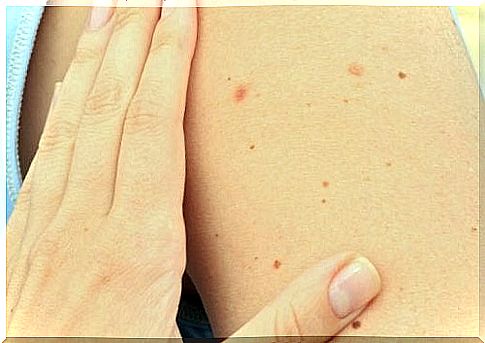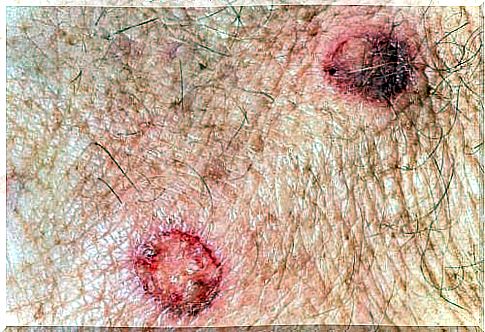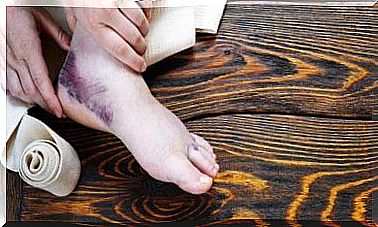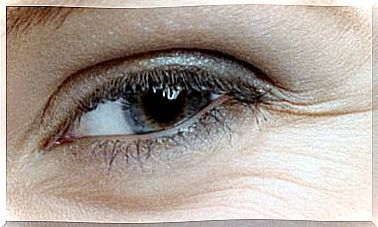What Do You Do If You Find An Abnormal Spot?

An abnormal spot is a sign that you should definitely watch out for. When there are changes in the appearance of a normal blemish, don’t ignore them. Any spot can turn into melanoma or skin cancer.
A spot is actually usually a group of pigment cells. Usually it is a benign buildup, which carries no further risks. It is normal for adolescents to have about 15 to 20 spots. For adults, that number can range between 20 and 40.
Most cases of skin cancer occur in people 40 years of age or older. Therefore, if an abnormal spot appears, you should definitely not postpone the visit to a specialist. In the long run, it can be a matter of life or death.
Identifying an abnormal spot

In order to identify and differentiate an abnormal blemish from common blemishes, you need to consider their five most important aspects. In English, this is also known as the ABCDE method. These letters stand for: Asymmetry, Borders, Colour, Diameter, Evolving. We will explain it below in Dutch.
- Asymmetry. An abnormal spot is asymmetrical. One half of the spot is different from the other half. This could be a sign of a malignant blemish.
- Irregularity of the edges. A normal fleck has a round shape with defined edges. If this is not the case and the edges are irregular, you should have it evaluated by a doctor.
- The color. Spots that are very dark or have a reddish color should be examined.
- The diameter. It is an abnormal spot if the diameter is greater than 6 mm. However, there are also small spots that can cause cancer.
- Spread. When there is a blemish or blemish and it starts to spread to the surrounding skin, get it checked out.
We recommend that you have your skin checked monthly to see if a new spot has changed in some way. It’s also a good idea to get your back checked.
Other Signs of Abnormal Spots
While the previous signs are most indicative of abnormal blemishes, they are not the only clues. In some cases, other symptoms may develop.
It is therefore important to pay attention to the following phenomena:
- Redness and inflammation. If the area around the spot turns red and/or becomes inflamed, you should immediately consult a professional.
- Other sensations. A normal spot does not cause abnormal sensations. If you’re experiencing itchiness, burning, or pain, there may be a problem.
- Surface changes. If you see blood, fluid, or peeling skins, be careful. Also note if there are any small lumps or bumps in the same spot.
We emphasize once again that in these cases you should urgently contact your doctor or the dermatologist. Only a professional in this field can determine if it is a malicious problem. So you should talk to him or her as soon as possible.
Spots and melanoma

Melanoma is a malignant tumor and a form of skin cancer. This type of cancer can occur at any age.
First, something that looks like a normal blemish appears on the skin. If detected in time, it is usually completely treatable and curable, but may have a tendency to reappear.
- Fair-skinned people are at the highest risk for melanoma.
- Also, exposure to the sun or using lamps with UV light without protection are risk factors.
In addition, melanoma would also occur in the same family in 10% of the cases. However, the US National Library of Medicine states that even people without a known family history can develop it.
The best prevention measures are to use sunscreen and avoid UV lamps. Wear a hat when you walk outside and the sun is very intense.
Diagnosis by a dermatologist

The first thing the dermatologist will do is inspect your skin closely. He or she looks in particular at the spots and their surroundings. They examine all parts of the body for signs of melanoma.
- They usually decide to do a skin biopsy if they find an abnormal spot. If possible, they will remove the blemish completely in the same biopsy.
- This sample is then subjected to a microscopic analysis in a laboratory. There, the specialists will determine whether or not there are cancer cells.
- The results of the biopsy should also indicate how deep the tumor is. This figure or level is usually expressed in millimeters. These data are decisive for the decision about a treatment and the preparation of a prognosis.
Some types of melanomas grow very quickly. In these cases, it is also necessary to have a biopsy of the lymph nodes near the tumor.
The specialists can also perform radiological examinations of the brain, neck, chest, abdomen, pelvis and bones.









